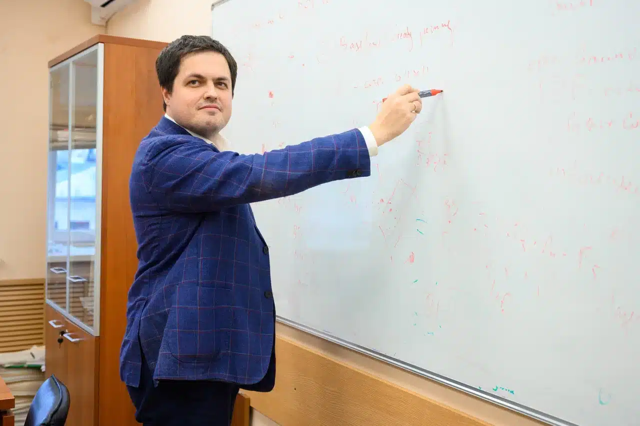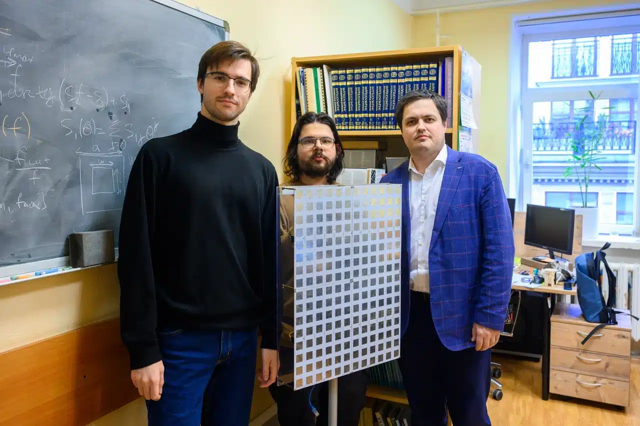Made in Russia: How a new data transmission method will enhance Wi-Fi speed. An interview with Yevgeny Khorov.
— You and your colleagues were the first in the world to create a prototype device with what's known as non-orthogonal access in Wi-Fi networks. As we understand, this is an important innovation in wireless networks. What's the concept behind it?
— Typically, only one stream of information can be transmitted from a single-antenna device to other single-antenna devices on the same frequency. However, with non-orthogonal access, you can use one antenna to send two different streams of information to two different devices, utilizing the same radio frequency resources. Conversely, it allows two streams from two devices to one antenna.
— How does that work? Are these two streams different in some way?
— The streams differ in power. Here's how it works: let's say two receiving devices are at some distance from each other, one closer and the other farther away. We transmit a combination of two messages, with each message weighted by its power. The message intended for the distant user is transmitted with slightly higher power, while the message for the closer user is sent with lower power. The distant user can isolate their message, perceiving the other message, which they are unaware of, simply as noise.
Since the power of their message is higher and the attenuation of both messages is the same, the distant user receives their message with greater power and can decode it. The closer user also decodes this message, but since it is not meant for them, they subtract the foreign message and decode the remaining part as their own. This method increases data transmission speed when we need to send data to multiple users or from several users.

— That's a beautiful technology!
— This is not our invention; it is well-known that information can be transmitted this way. However, when we began our work, this topic was just gaining traction, and there were no ideas on how to implement this method in Wi-Fi networks. We created the world's first prototype of Wi-Fi devices that utilize non-orthogonal access. Of course, we are still far from a real market product, a new type of router. However, we have demonstrated that it works at all. One of the connected devices was a regular laptop that had no idea that non-orthogonal access was being used. We managed not only to integrate this technology into Wi-Fi but also to make this method backward compatible.
This result holds significant practical value because modern Wi-Fi networks can have devices of different generations operating simultaneously, and the access point must communicate with one device using one version of the protocol and with another device using a different version. Thanks to our approach, the same radio resources can be used simultaneously to communicate based on different data transmission principles. One stream can be for older devices, while another can be for newer ones. This is critical for supporting real-time applications, where low latency in data delivery is essential. By being able to transmit data simultaneously, we can reduce latency. This prototype won the award for the best demonstration experimental development at the MobiHoc conference in 2022 (one of the top conferences in the field of information technology). We proposed to incorporate this idea into the new Wi-Fi standard. Although we were unsuccessful (not all proposals are accepted, unfortunately), we received feedback that standardization is not required. Because we demonstrated how to achieve backward compatibility, there is no need to integrate this development into the Wi-Fi standard; manufacturers can implement this approach without regard to the standard, simply because the technology is compatible with any standard. We have been working on this development for several years.
— How is the "kitchen" of your work organized? Do you need engineering ingenuity or programming skills? Do you and your colleagues create devices or write code?
— We work at the intersection of mathematics, programming, and engineering. It's important to understand that telecommunications belong to technical sciences, and scientific developments must be embodied in new communication devices and technologies. Part of my doctoral work was incorporated into the Wi-Fi 6 standard. The methods that arose from attempts to answer scientific questions were implemented as part of the Wi-Fi standard.
— So you are engineers with strong mathematical skills in data transmission.
— One must be careful when discussing the strength of our mathematics. Pure mathematicians would say that there are no millennium mathematical problems in our industry and that we do not have fundamental challenges. Fundamental mathematics sets its own problems and develops independently, while in the technical field, problems are posed by practice, and development is driven by technical demands. Most applied specialists often lack the time to develop new mathematical frameworks; we use already known frameworks to solve specific engineering problems. Nonetheless, there are examples where entire fields of mathematics have originated from technical problems, subsequently diverging far from the original challenges for which they were created. Thus, the boundary between applied and fundamental mathematics is indeed permeable.
— You mentioned that your work was incorporated into one of the past Wi-Fi protocols. Why are Wi-Fi manufacturers interested in your scientific work or that of others? Why was this important to them?
— We work with manufacturers of telecommunications equipment, with international companies. The situation has worsened somewhat recently for understandable reasons, but I believe this is temporary, and we will expand significantly in the future, working not only with international companies but also with Russian ones. Our laboratory develops new algorithms that enhance data transmission performance, and we participate in creating solutions for manufacturing firms and in standardization, meaning we bring some of our solutions to international standards. If a manufacturer wants to produce equipment that operates under the Wi-Fi standard protocol, they must support our solutions. In one of our proposals that became part of the Wi-Fi standard, it took a long time to explain to representatives of leading communication companies why our solution was good. In reality, these were interesting and productive discussions, resulting in adjustments to our vision. It is a complex process, but if you propose solutions that will improve technology, they can be incorporated into the standard.
— How are standards accepted that impact markets and manufacturers? Who has the final say?
— Right now, a meeting of the Standardization Committee is taking place in Vancouver, and I, along with five others from our team, are participating remotely. Engineers and scientists from global technology companies participate in the development of the standard, but several scientific centers are also represented, including our group from Russia. There are about 500 people in total. For a decision to be accepted, it must receive three-quarters of the votes.
— Given that your group is one of the few scientific groups in this committee, it is at the level of developers from the largest global companies.
— We strive for that. We have a young team, but we aim to perform at a very high level.

When Will Innovations Be in Demand in Russia?
— Are Russian industrial manufacturers participating in this process, or are they lagging behind?
— Russia began to realize the need to produce telecommunications equipment for wireless communication only a couple of years ago. We see certain measures at the government level, but these measures are clearly insufficient. Currently, several companies involved in creating domestic mobile communication equipment are focused not on making their equipment better than imported alternatives but simply on ensuring that it works at all. Sadly, foreign companies are still collaborating with Russian scientists, and only later do Russian companies purchase foreign products and technologies that incorporate Russian developments.
However, the positive aspect is that, thanks to the efforts of Russian scientists working with foreign companies, even under current conditions, there are competence centers in high-tech areas in Russia. I hope that someday Russian companies, which are currently trying to develop domestic equipment, will reach a point in their development where they understand that they need smart algorithms and new technological solutions, not just as laboratory samples but as products for millions of users. At first glance, it seems that creating equipment in the communication field only requires opening specifications (most of which are open) and implementing them.
It seems that no research and development is necessary; everything is written down — we read, convert the text into code, and launch it; everything should work. In practice, this is not the case at all. Any standard is framework-based and describes only the minimal functionality necessary for two devices to understand each other. An analogy would be: we speak Russian, and the Russian language is a sort of standard. We can write messages to each other and understand them. But the thoughts we convey to each other are not inherently embedded in the Russian language; they are our own thoughts. The task of intelligent algorithms is not only to send a message but to understand how, when, and with what parameters this message should be sent.
One of our early industrial projects with a major telecommunications equipment manufacturer yielded the following result. Without changing the parameters of the physical channel, we managed to transmit data in such a way that web pages loaded for users one and a half to two times faster. It turned out that a twofold increase in performance could be achieved without changing anything except for a short algorithm. But this algorithm was the result of a lengthy and complex investigation. And this, in my opinion, is the most fascinating aspect of our work, because when you have studied a lot and finally arrive at a compact and highly efficient solution, it is the most rewarding and exciting part of our work.
—